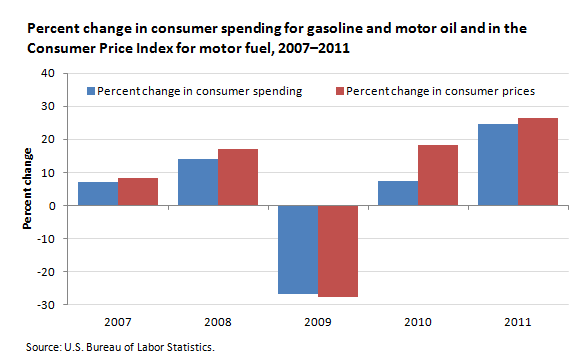An official website of the United States government
 United States Department of Labor
United States Department of Labor
Consumer expenditures on gasoline and motor oil increased significantly in 2011, following a smaller increase in 2010. Consumer units spent an average of $2,655 on gasoline and motor oil in 2011. That was 24.5 percent more than they spent in 2010 ($2,132).

| Year | Percent change in consumer spending | Percent change in consumer prices |
|---|---|---|
2007 | 7.0 | 8.2 |
2008 | 13.9 | 17.0 |
2009 | -26.9 | -27.8 |
2010 | 7.4 | 18.4 |
2011 | 24.5 | 26.5 |
Despite the increase in 2011, expenditures on gasoline and motor oil remained below their peak of $2,715 in 2008. For the most part, the trend in consumer spending followed price fluctuations. As the price of motor fuel increased, consumers spent more on gasoline and motor oil, and as the price of motor fuel dropped, consumers spent less. From 2007 to 2009, annual consumer spending on gasoline and motor oil rose and fell by roughly the same percentage as the change in the Consumer Price Index for motor fuel. As a result, the quantity consumed changed little during that time.
In 2010, consumers increased their expenditures on gasoline and motor oil (7.4 percent) by less than half of the percentage change in price (18.4 percent), indicating a decrease in the quantity consumed. In 2011, the percentage increase in spending on gasoline and motor oil (24.5 percent) approximately equaled the increase in the price index of motor fuel (26.5 percent), meaning that spending and prices returned to their earlier pattern.
These data come from the Consumer Expenditure Survey and the Consumer Price Index. To learn more, see "Consumer Expenditures in 2011" (PDF), BLS Report 1042. Consumer units include families, single persons living alone or sharing a household with others but who are financially independent, or two or more persons living together who share expenses.
Bureau of Labor Statistics, U.S. Department of Labor, The Economics Daily, Consumer spending on gasoline increased significantly in 2011 at https://www.bls.gov/opub/ted/2013/ted_20130711.htm (visited April 16, 2024).

